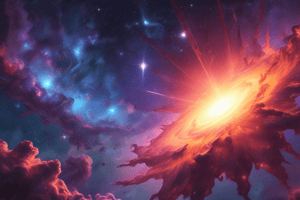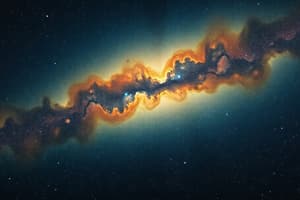Podcast
Questions and Answers
Which of the following best describes a nebula?
Which of the following best describes a nebula?
- A planet formation site
- A dense star
- A black hole
- A cloud of dust and gas that floats through space where protostars are born (correct)
What triggers the birth of a star?
What triggers the birth of a star?
A disturbance in a nebula causes its center to begin collapsing from gravity.
It could take 50 million years for a protostar to become an adult star.
It could take 50 million years for a protostar to become an adult star.
True (A)
Hydrogen atoms bond to create a new star in a process called?
Hydrogen atoms bond to create a new star in a process called?
Which of the following best describes the relationship between red dwarfs and giant stars?
Which of the following best describes the relationship between red dwarfs and giant stars?
The sun is ________ star.
The sun is ________ star.
Which of the following best describes the death of a red dwarf?
Which of the following best describes the death of a red dwarf?
A supernova occurs every time a star dies.
A supernova occurs every time a star dies.
Which of the following is true of black holes?
Which of the following is true of black holes?
Neutron stars are the result of?
Neutron stars are the result of?
Flashcards are hidden until you start studying
Study Notes
Nebula and Star Formation
- A nebula is a cloud of dust and gas in space where protostars are formed.
- The birth of a star is triggered by a disturbance in a nebula, causing its center to collapse under gravitational forces.
Protostar Development
- The development from protostar to adult star can take approximately 50 million years.
Nuclear Fusion
- Stars are formed when hydrogen atoms bond through a process known as nuclear fusion.
Star Types and Longevity
- Red dwarfs consume energy more slowly than giant stars and have a longer lifespan.
The Sun
- The sun is classified as an average-sized star.
Red Dwarf Lifecycle
- The death of a red dwarf occurs when hydrogen depletes in its core, leading to cooling and transformation into a white dwarf.
Supernova Events
- A supernova does not occur with every star's death; it is a specific and explosive endpoint for certain stars.
Black Holes
- Black holes are characterized by their exceptionally strong gravitational pull, affecting surrounding matter.
Neutron Stars
- Neutron stars are formed through the combination of protons and electrons, resulting in a dense stellar remnant.
Studying That Suits You
Use AI to generate personalized quizzes and flashcards to suit your learning preferences.




